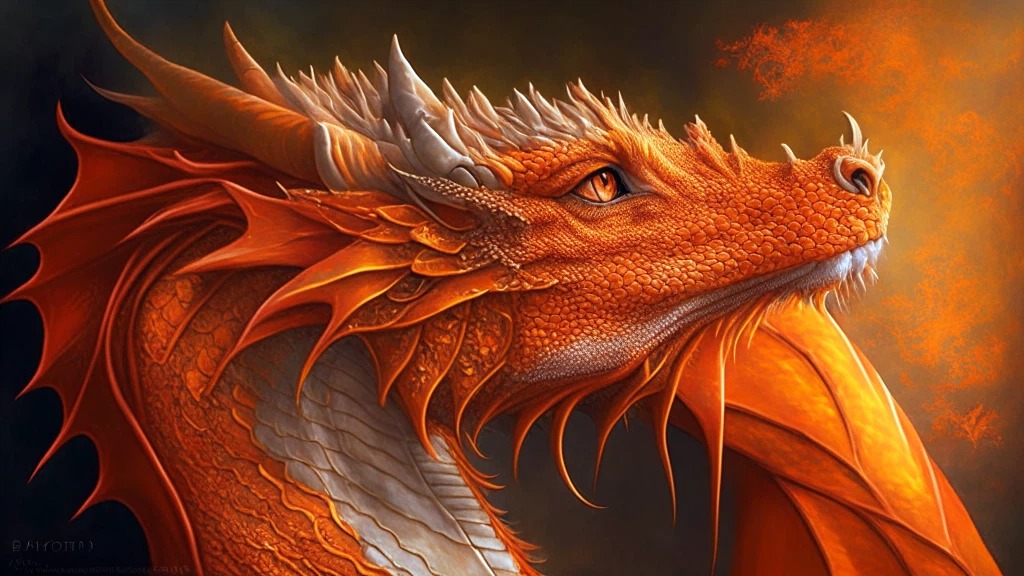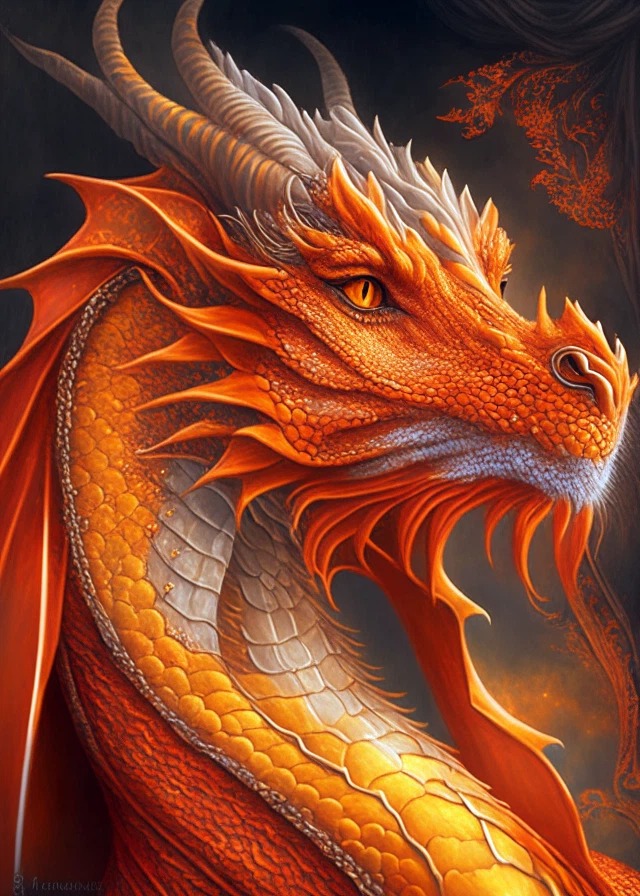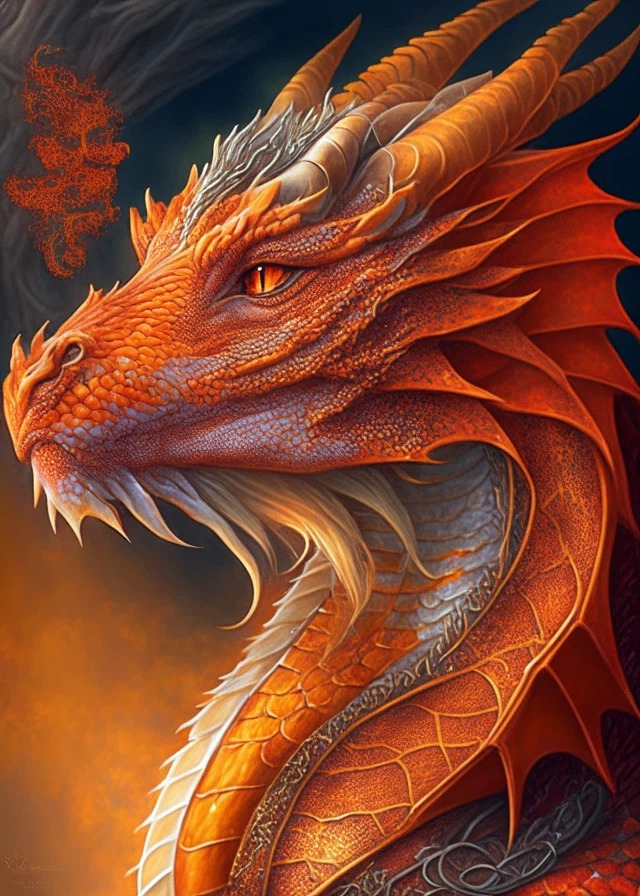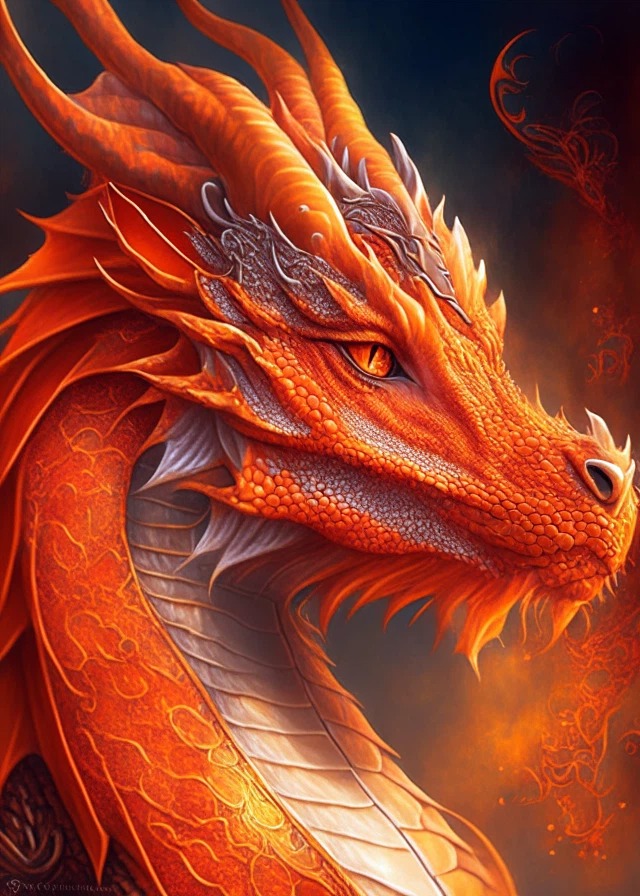Orange Dragon
Orange dragons are energetic and adventurous beings with a zest for life and a love of new experiences. Their vibrant orange scales reflect their exuberance and curiosity. Impulsive and quick to take risks, they often find themselves in exciting and daring situations. With a strong sense of wanderlust, they crave travel and exploration. Despite their impatience, they are friendly and fun-loving, making them popular companions. Known for their positive outlook and joyous spirit, they bring a sense of excitement and adventure wherever they go.
Imprinting
Imprinting for orange dragons is deeply connected to individuals who have a love for life and an insatiable thirst for new experiences. These dragons are drawn to those who approach life with unbridled curiosity, embracing each day with excitement and enthusiasm. They favor individuals who might be a little impatient and impulsive, as they often lead the most interesting and adventurous lives. When an orange dragon chooses a rider, both the dragon and the potential rider are closely observed, as their shared adventurous spirit may lead them to engage in some risky and daring activities in the pursuit of fun and novelty. While this zest for life makes them thrilling companions, it also requires some careful guidance to prevent them from taking unnecessary risks. Orange dragons also enjoy imprinting on individuals with a laid-back view toward rules and a strong interest in travel. Their free-spirited nature and openness to new experiences make them natural wanderers, always seeking out new places and cultures to explore. Together, orange dragon riders and their companions embark on a journey filled with excitement, spontaneity, and a sense of wonder. Their thirst for life and their adventurous spirit make them unforgettable characters, enriching their lives and the lives of those they encounter along the way.| Positive Traits | Negative Traits | Benefit | Ban |
|---|---|---|---|
| Energetic
Joyful Playful |
Impatient | +1 to any roll involving stamina | -1 to any roll where you must be patient |
Notable Dragons
|
PaendudoasName Meaning: The Fast One Adult Male Age: Rider: ??? Personality: |
RaimirName Meaning: The Life Giver Adult Female Age: Rider: ??? Personality: |
Basic Information
Anatomy
The anatomy of orange dragons is awe-inspiring and befitting of their fiery nature. Here are some of their remarkable physical characteristics:
- Coloration: Orange dragons are adorned with vibrant and striking shades of orange, ranging from fiery oranges to soft tangerines. Their brilliant and eye-catching coloration makes them stand out in their natural environment.
- Wings: Orange dragons possess large and powerful wings with a combination of vibrant orange hues and contrasting patterns. These wings allow them to perform acrobatic maneuvers and achieve impressive speeds in flight.
- Eyes: Their eyes often gleam with a warm and lively orange glow, mirroring their energetic and enthusiastic demeanor. Their expressive gaze conveys their passion for life and their adventurous spirit.
- Horns and Crests: Orange dragons have majestic and prominent horns that curve gracefully from their heads. Some individuals may also have decorative crests or frills along their spine, adding to their charming and spirited appearance.
- Sharp Claws and Teeth: While they are more known for their playful and energetic nature, orange dragons still possess sharp claws and teeth that serve them well in playful scuffles and friendly wrestling matches.
- Agile Build: Orange dragons have a nimble and agile build, which complements their adventurous and spirited personality. Their lithe physique allows them to navigate challenging terrains with ease and agility.
- Tails: They have long and expressive tails that mirror their energetic and playful nature. Their tails are often used for balance and expressing emotions, swishing with excitement or curiosity.
Genetics and Reproduction
The reproductive process of dragons is both spectacular and fascinating. When the mating season arrives, potential mates engage in a breathtaking aerial courtship display. The two partners take to the skies and fly high together, showcasing their agility and grace. As they soar, they demonstrate their mutual attraction and compatibility, engaging in acrobatic displays that are a blend of love play and a reflection of their affinity for speed and risk.
When the time is right, the two dragons enfold each other in their wings, forming an intimate bond as they descend in a thrilling free-fall. At the crucial moment, just before reaching the ground, they open their wings, slowing their descent, and land safely together. This adrenaline-filled mating ritual further cements their connection, and the exhilaration of the flight adds to the depth of their bond.
After the successful mating, the female dragon proceeds to lay eggs, similar to reptiles and birds. These eggs are protected by a hard shell, which provides a secure environment for the developing embryos. A typical clutch consists of about five eggs, though this number may vary slightly among individuals and species.
The incubation period for dragon eggs is significantly longer than that of typical birds or reptiles. It spans a year, during which the female dragon vigilantly guards her precious eggs, displaying maternal instincts to ensure their safety. During this period, the female dragon is incredibly protective, allowing only her bonded rider or trusted individuals of the Skysworn guild to approach the nest.
One of the remarkable aspects of dragon reproduction is the potential variety in egg colors within a single clutch. While certain colors might be more common, there is always a chance that a dragon clutch could contain eggs of any color, including rarer hues. The diversity of egg colors adds an element of surprise and wonder to the world of dragons, reflecting the mysterious and magical nature of these majestic creatures.
Growth Rate & Stages
The growth rate and life stages of dragons vary depending on the species and the world's specific lore. However, here's a general outline of their life stages and growth:
On the rare occasion when a rider dies while their dragon survives, it is an equally tragic event. The surviving dragon will let out a cry of anguished loss, reflecting the deep bond they shared with their rider. In the aftermath of the rider's death, the dragon will disappear, vanishing into another realm, carrying the body of their fallen companion with them. The fate of the dragon after they disappear remains a matter of speculation and mystery within the guild. Some believe that the dragon may die shortly after, unable to bear the loss of their rider. Others speculate that the dragon may cross into an afterlife or another dimension where they are reunited with their rider, finding solace in their eternal bond.
- Hatchling: Dragons start their lives as hatchlings, emerging from eggs after a period of incubation. At this stage, they are small and vulnerable, relying on their parents or guardians for protection and nourishment. Hatchlings are often unable to fly and may stay close to their nesting site.
- Wyrmling: As dragons grow older, they enter the juvenile stage. During this period, they experience rapid growth and development. Juvenile dragons begin to explore their surroundings and practice their flying abilities. Their scales and wings continue to strengthen, preparing them for adulthood.
- Young: The adolescent stage is a critical phase for dragons. They become more independent and may start developing their unique personalities. At this point, they begin honing their combat skills and refining their magical or psionic abilities. The process of imprinting and bonding with members of the Skysworn guild typically occurs during this stage.
- Adult: Once a dragon reaches adulthood, it attains its full size and power. Adult dragons are fearsome creatures, possessing their signature fire-breathing abilities and other magical or psionic powers. They become influential beings in their world, often holding a significant role in the ecosystem and society.
- Elder/Ancient: Dragons that have lived for an extended period enter the elder or ancient stage. At this point, they become wise and experienced, accumulating vast knowledge and insight. Elder dragons may serve as respected leaders or sages, guiding younger generations and playing pivotal roles in the world's events.
| Stage | Size | Age Range |
|---|---|---|
| Hatchling | Small | 0-3 months |
| Wyrmling | Medium to Large | 3 months - 1 year |
| Young | Large | 1-30 years |
| Adult | Large | 30 - 100 years |
| Ancient | Large | 100 years or more |
Ecology and Habitats
Dragons thrive in diverse environments that cater to their unique characteristics and needs. However, their optimal habitat encompasses a combination of elements to ensure their well-being and dominance in the ecosystem. Large open spaces provide them with ample room to spread their wings and take flight, a fundamental aspect of their identity as sky-bound creatures. These open spaces grant them the freedom to soar high above the lands and survey their territories, reinforcing their sense of majesty and power.
Mountainous regions hold a special allure for dragons. The rugged terrain grants them secluded nesting sites and lairs where they can protect their eggs and young hatchlings from potential threats. The high vantage points in the mountains also offer ideal locations for dragon roosts, allowing them to keep a watchful eye over their domain and detect any intruders or rival creatures.
Magical nexus points are of particular significance to dragons. These sites resonate with powerful magical energies, which can further enhance their innate magical or psionic abilities. As creatures attuned to the magical fabric of their world, dragons are drawn to these places as sources of strength and connection to the mystical forces that flow through the land.
The presence of adequate prey and resources is vital for sustaining the dragon population. Dragons are formidable predators, and their large size demands a substantial intake of food. In regions with abundant prey, such as large herds of animals or other magical creatures, dragons can maintain their strength and vitality. Additionally, access to natural resources, such as freshwater sources and minerals for their scales and bones, is essential for their physical well-being and for maintaining their impressive appearance.
Dietary Needs and Habits
Dragons are formidable predators with diverse dietary preferences. Their diet primarily consists of various creatures, including large mammals, other magical beings, and sometimes even livestock from human settlements. To hunt or forage for food, dragons utilize a combination of their physical prowess, magical abilities, and intelligence.
When it comes to hunting, dragons leverage their exceptional aerial agility and speed to their advantage. They often employ stealth and patience, silently soaring through the skies to spot potential prey from great distances. Once they have identified a suitable target, they dive with incredible speed and precision, using their sharp claws and teeth to capture their quarry. The element of surprise and their swift attacks make them formidable predators, instilling fear in those who dare to cross their path.
For larger and more elusive prey, dragons might use their magical or psionic abilities to their advantage. Some dragons possess the power of mesmerization or illusions, allowing them to deceive and disorient their targets before striking. Others might use telekinesis to immobilize or manipulate their prey, making the hunt more effortless and efficient.
Dragons are known for their intelligence and strategic thinking, and this extends to their approach to food storage and protection. They might establish hidden lairs within mountainous regions where they store excess food reserves. These lairs serve as secure caches, safeguarding their precious food sources from scavengers and rival predators. The nesting sites for their eggs are often strategically chosen to provide a safe and well-guarded environment for their young, ensuring the continuation of their species.
Additionally, the maternal instincts of female dragons play a crucial role in protecting their food sources. During the incubation period of their eggs, the female dragon remains fiercely protective, keeping a watchful eye on the area surrounding the nesting site. She will deter any intruders, ensuring that no other creatures, be they predators or curious explorers, can disrupt or threaten the safety of her clutch or nearby food caches.
Behaviour
The behavior of orange dragons is marked by their extreme energy and playfulness, which remains vibrant even as they age. They possess a joyful zest for life that rivals any of the other dragon colors. Keen risk-takers, these dragons often engage in daring adventures, collecting the most thrilling and captivating stories along the way. Their wanderlust is fueled by their impulsiveness and, more importantly, their insatiable curiosity.
Orange dragons are driven by a strong desire to explore and experience new things, constantly seeking to satisfy their adventurous spirits. Their playful and curious nature can sometimes lead them into dangerous situations, making them more susceptible to early mortality compared to other dragons.
Despite their sometimes bothersome presence, orange dragons are welcomed among their kin due to their infectious enthusiasm and the excitement they bring to the dragon community. Their vibrant energy and love for storytelling make them captivating companions, leaving a trail of fascination and inspiration wherever they go.
Orange dragons stand out as lively and spirited creatures, infusing a sense of adventure and wonder into the lives of those around them. Their willingness to take risks and embrace new experiences makes them cherished members of the dragon community, despite the challenges that come with their exuberant nature.
Additional Information
Perception and Sensory Capabilities
Dragons possess a diverse range of sensory abilities that allow them to gather information about their environment and the world around them. These sensory abilities go beyond the ordinary senses.
- Enhanced Vision: Dragons have exceptional vision, allowing them to see great distances and even in low-light conditions.
- Enhanced Hearing: Dragons may have acute hearing, allowing them to pick up on sounds beyond the range of normal human hearing. This heightened sense can help them detect approaching dangers or locate prey.
- Telepathy: As mentioned earlier, dragons in OE are telepathic beings. This powerful ability allows them to communicate directly with individuals of the Skysworn guild and possibly with other sentient creatures they encounter.






Comments